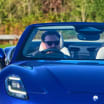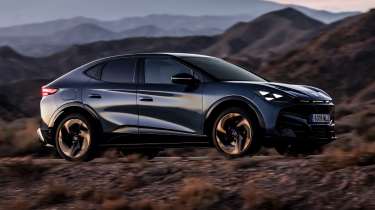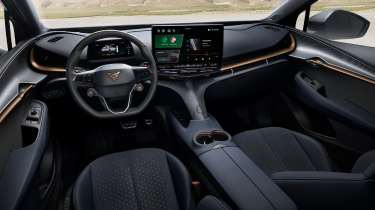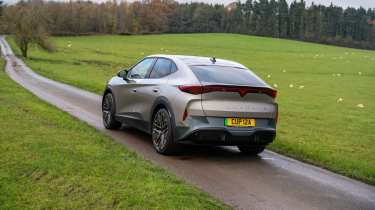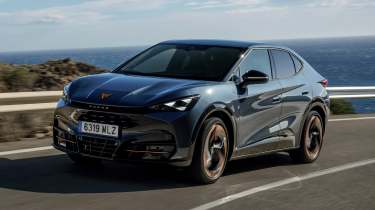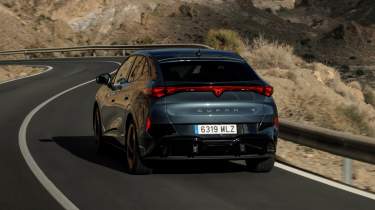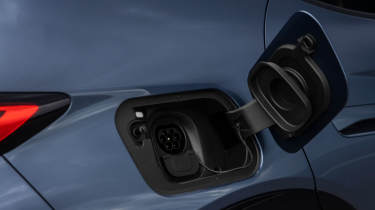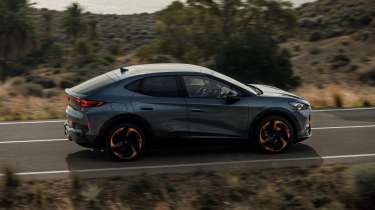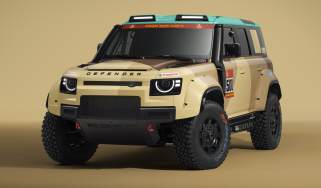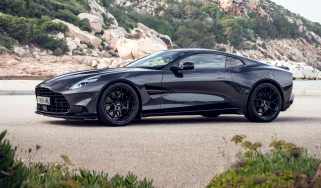Cupra Tavascan 2025 review – the Ford Capri’s more interesting Spanish cousin
The Tavascan is Cupra’s coupe SUV based on the Volkswagen Group’s MEB electric vehicle architecture, whose closest relations are the Volkswagen ID.5, Ford Capri and Skoda Enyaq
Evo verdict
Cupra has had some level of success in giving its EVs more personality and dynamism than others built on the Volkswagen Group’s MEB architecture. That continues with the new Cupra Tavascan – cousin (and key C-segment rival) to the Ford Capri, Volkswagen ID.5 and Skoda Enyaq.
It’s the best-looking and most interesting, inside and out, with dynamics that are as well-resolved as they can be for this sort of car. It doesn’t however have the extra edge and playfulness by comparison to the ID.5 GTX, that say, the Cupra Leon has over its cousin, the Golf GTI. The Tavascan’s main distinction is in its design flair, rather than the way it drives.
Background and model range
The Cupra Tavascan is the latest model to come from the MEB family of electric cars from the Volkswagen Group. What started with the Volkswagen ID.3, ID.4 and ID.5, lead a family of platform-mates from Skoda, Audi, Seat and Cupra, with Ford even joining the (world’s dullest) party thanks to a deal it struck with VW, resulting in the new Explorer and Capri. The Capri, the VW ID.5 and the Skoda Enyaq are the Tavascan’s closest relations and rivals, with the Cupra bringing a bit of extra design flair and driving dynamism by comparison.
More reviews
Group tests
- Lotus Emira Turbo SE v Alpine A110 GTS – two of the last surviving mid-engined sports cars
- Alpine A290 v Alpine A110 – how much DNA do they really share?
- Ariel Atom 4R v Caterham Seven ‘evo25’: power-to-weight heroes go head-to-head
- Ariel Atom 4 v Caterham Seven 310R v Lotus Elise Cup 250
- £200,000 supercar shoot-out: AMG v Aston Martin v Maserati v McLaren
- Audi Quattro, RS2 and RS3: five-cylinder icons head-to-head
- Who makes the best GT car? Aston Martin v Bentley v Maserati
- Caterham Super Seven 600 v Super Seven 2000
- Corvette Stingray v Porsche Cayman GTS v Audi R8 RWD
- Great Ferrari hypercars driven: 288 GTO, F40, F50 and Enzo head-to-head
In-depth reviews
- Abarth 600e 2025 review – Italy gives the Alpine A290 something to worry about
- Alpine A110 review – the sports car Lotus should be building
- Aston Martin Vantage 2025 review – a thrilling Mercedes-AMG GT and 911 Turbo S alternative
- Used Audi RS2 (1994) review – an unsung '90s hero you can own for £40k
- Audi R8 (2015 - 2024) review – the ultimate soft-focus supercar
Long term tests
- Abarth 695C Turismo Fast Fleet test – living with the charming Italian hatch
- Alfa Romeo Giulia Veloce Fast Fleet test – living with the sharp Italian saloon
- Aston Martin Vantage (2006) Fast Fleet test – living with a £30k V8 Aston
- Caterham Seven evo25 Fast Fleet test – living with a track car for the road
- Caterham Seven evo Edition revealed – bespoke 420R joins the Fast Fleet
- Cupra Leon 300 Fast Fleet test – living with Spain's 300bhp hot hatch
- Cupra Ateca VZN Fast Fleet test – four months with Cupra's hot crossover
- Cupra Leon Estate 310 4Drive Fast Fleet test – living with the 306bhp hot estate
- Ford Mustang GT
- Ford Mustang GT
Review
- New Bentley Batur 2023 review – can it possibly be worth £1.65m?
- 2023 Chevrolet Corvette C8 Z06 review – the American 911 GT3?
- BBR Supercharged Mazda MX-5 (ND) 2023 review – tuned 250bhp roadster driven
- MG4 Trophy 2023 review
Reviews
- Abarth 695 75 Anniversario edition 2024 review – a fitting send-off for Abarth’s hot supermini?
- Abarth 500e 2023 review
- AC Cobra 378 Superblower MkIV 2021 review – another V8 Cobra, but with a GM heart this time
- Acura Integra Type S 2024 review – a Honda Civic Type R with added restraint
- Alfa Romeo Giulia 2025 review – get one while you still can
- Alfa Romeo 33 Stradale 2025 review – a rare Italian jewel beyond compare
- Alfa Romeo SZ: history, review and specs of an icon
The range starts with the 282bhp single-motor V1, priced from £47,350. The dual-motor, 335bhp VZ is billed as the performance model and is the one we’re most interested in, and have driven here. VZ-spec Tavascans are priced from £55,945.
Interior and technology
- Genuinely interesting interior design (bar the borrowed bits)
- Excellent bucket seats in VZ-spec cars
- Spacious and comfortable for all occupants
Volkswagen Group cars don’t tend to divert from the norm when it comes to design. Save perhaps for Cupras, which have established a distinctive exterior design language, albeit one that is a little too copy and paste from one model to the next. The same cannot be said for the inside of the Cupra Tavascan.
Open the door, look past the generic screen, steering wheel and driver’s display and the architecture in this cabin is genuinely amazing. It’s like Cupra’s interior designers had a look at some of H.R Giger’s work and went ‘yes, that but a little less frightening, and in bronze.’ Most striking is the ‘central spine’ that seamlessly flows down from behind the infotainment screen and the dash.
It’s almost without purpose, floating there with nothing but the hazard light button inset – design for design’s sake. Behind it, storage – or wireless charging – for your phone. Then there are the air vents, that look like the engine intakes for a space ship from an Avengers or Superman movie. All the materials are reasonably nice too – a lot of plastic with a metal effect, granted, but with a smooth feel and good fit and finish. Bravo.
The driver’s display, per all MEB models, is a bit too dystopian and minimalist for our tastes, though the new HUD with AR works well. The large 15-inch infotainment screen is crisp and responsive, even if the software – generic, with a Cupra colourway – is still not the most intuitive. You’re still forced to interact with it too, for the climate controls.
Seats and boot space
Even in the bucket seats you sit a little high, though the seats themselves (whether the optional buckets or not) are very good. There’s plenty of head and legroom (especially for a ‘coupe SUV’) and an airy feel to the cabin, only corrupted by the sloping coupe roofline. The 540-litre boot capacity should be enough for most – it’s 40 litres more than a plug-in hybrid BMW M5 Touring.
Powertrain and technical highlights
- 282bhp as standard or 335bhp in the Tavascan VZ
- Dynamic Chassis Control damping standard on all but the entry model
- 135kW battery charging behind MEB platform-mates
With the battery mounted centrally, weight distribution is a balanced 49:51 front to rear. The Tavascan is suspended by MacPherson struts at the front, with a multi-link rear end design. Per the rest of the Cupra range, the Tavascan puts more focus than its Group relations on dynamics. Sport suspension is a given, which means all Tavascans are nominally lower (and stiffer) than say, a Volkswagen ID.5. Dynamic Chassis Control 15-way adjustable dampers are standard fitment on all but the entry-level Tavascan V1.
The wheels are large 21-inch items with 255-section, 40-profile tyres front and rear in the VZ. Slimmer 235-section tyres are standard fitment for the rear-driven models. All Tavascans weigh over 2 tons, with the rear-drive cars coming in at 2178kg at the kerb, and the VZ models with their extra motor crushing the scales at 2267kg. Big weight and decent power means beefy 358mm brake discs up front, with 280mm drums at the rear.
Power, torque and 0-62mph time
The Tavascan VZ uses a 77kWh battery to power two electric motors, one on each axle, for a combined 335bhp and 402lb ft. That allows it to reach 62mph from a stop in a brisk 5.5sec. That rises to 6.8sec in the 282bhp rear-drive models. The top speed is 112mph across the board.
Performance, ride and handling
- Responsive and ample electric performance
- Refined high-speed ride, choppy low-speed ride
- Poor handover between regenerative and friction braking
As usual in Cupra models, tailoring the Tavascan’s drive modes is necessary to get the best out of it. For the most aggressive throttle response and the most steering weight, Cupra mode is one tap of the steering wheel-mounted button away – the one with the Cupra logo on it.
You can explore the other modes, including an individual mode where you can mix and match parameters for the powertrain and steering, via the Drive button on the opposite side of the wheel. Further configurability is then also possible via the infotainment screen, where you can alter the stiffness of the dampers via a sliding scale, changing how firm and controlled, or soft and comfortable you want the Cupra to be.
For most road driving, we found two-thirds to three-quarters of the way towards the left on the DCC slider, towards the firm side, was optimum. This afforded the Tavascan the best compromise of body and wheel control, as well as relative compliance. Next to much lighter combustion models like the Cupra Leon, the Tavascan with its large 21-inch wheels isn’t quite so well resolved in terms of secondary ride, with the sudden low-speed impacts of urban and rural village motoring arriving with an unnerving thud that echoes through the frame.
> Skoda Kodiaq vRS 2025 review – a seven-seat Golf GTI?
Get up to speed though and the Tavascan gathers itself and exhibits impressive control and refinement, though push too hard and its weight and relative height start to make themselves felt, as the tyres begin to struggle and the car starts falling over itself. A brisk pace, rather than flat-out, is its comfort zone. The steering is responsive if not laden with feel and the balance is almost unwaveringly neutral. If anything, the rear-driven car has more of a sense of adjustability.
The Cupra Tavascan is a brisk, responsive car to operate. As with all electric cars, the stated figures betray the considerable feeling of acceleration and response both from a standstill and on the move. There’s no lag, no delay, when you ask for the Tavascan’s potency. Even the 282bhp of the rear-driven model is plenty to be making progress with but the VZ’s extra motor, on top of bumping power up to 335bhp, also adds a dimension of almost resolute, undefeatable traction. It’s an unlikely point and squirt weapon.
All told the Tavascan doesn’t buck convention by being a properly engaging MEB-based car. Far from it, but it’s not bad. The most obvious blot in its dynamic copybook is in the brakes. They’re fine at speed but the exchange between friction and regenerative braking is less a handshake and more an awkward fumble – something very few manufacturers have managed to really nail. The result is almost a surging feeling before you come to a stop, where you have to add noticeably more brake pressure to maintain the rate you were slowing at, before the regenerative element was pulled.
You can manage the regenerative braking via the paddles, with the left one increasing the rate of deceleration – sort of how it would in a paddleshift ICE car with engine braking. My personal preference is to coast as much as possible, rather than go through the back and forth of acceleration and deceleration that comes with the use of regen.
Driver’s note
“The surge forward at low speed as the car hands over braking from the regenerative system to the discs and pads is quite unnerving and really takes some getting used to. This isn’t a Cupra-exclusive issue, though.” – Ethan Jupp, evo web editor, who tested the car on the road in the UK.
Efficiency, charging and running costs
- 77kWh battery is stretched a bit thin on high-spec models
- Efficiency is around 3 miles per kWh in real world use
- AWD VZ is less efficient thanks to its two electric motors
Official range for the VZ stands at 320 miles, while the rear-wheel drive models offer up to 352 miles of range officially, in V1 spec with the smaller 19-inch wheels. V2 spec brings 21-inch wheels and a drop to 339 miles of range. A 77kWh battery features across the range. Unlike in the Cupra Born VZ, a 79kWh battery option (that can charge at 185kW) isn’t offered.
All Tavascans seem to be a generation behind by comparison to say, the Cupra Born range, which will charge at 175kW across the board, or at up to 185kW in the case of the Born VZ. Still, a Tavascan can go from 10 to 80 per cent charge in 28 minutes when charging at full power. There are three levels of regenerative braking, as well as a fully off setting.
Being a bigger, heavier sort of EV than say, a Renault 5, the Cupra Tavascan can eat through its available energy if you’re not considered with your throttle usage and power management. On average you should see around 300 miles of driving from a full charge and over 3 miles per kWh in the rear-drive car. The all-wheel-drive car is a bit thirstier, achieving around 250 miles in the real world.
It’s worth noting, all Cupra Tavascan buyers will be on the hook for the ‘expensive car supplement,’ a £395 per year tax for the first five years, attached to new cars costing over £40,000.
Prices and buying options
Prices for the Cupra Tavascan start from £47,350 for the rear-drive V1. Even in this specification it gets LED headlights, adaptive cruise, full climate control and the full 15-inch infotainment suite, with Android Auto and Apple CarPlay. It’s not a car that feels ‘entry level’ like some can, with blank switches and fewer premium materials.
Move up to V2 spec for £53,845 and matrix LED lights join the spec sheet, along with a panoramic sunroof, Sennheiser audio, DCC dampers and larger 21-inch wheels – the latter a possible downgrade in terms of comfort and range. Even so, it’s potentially the pick of the range when adding up what you get against what you’re paying.
Or, for £55,945, there’s the 335bhp, dual-motor VZ. VZ2 spec lunges over the £60k mark at £60,845, though you do get the Cup bucket seats and ‘Etna’ alloy wheels. The winter pack for £1335 adds a heat pump, front and rear seat heating and a heated windscreen.
Rivals
The Tavascan is aimed squarely at its platform-mates, the Volkswagen ID.5, Skoda Enyaq and Ford Capri. If you need a boxier profile for added practicality, the Volkswagen ID.4, Ford Explorer and Enyaq SUV will be the obvious alternatives. The Cupra falls down by comparison in some respects, given it doesn’t get the faster-charging, 79kWh battery option. The top-flight 335bhp Capri gets the 79kWh battery and is available from £56,185. The Volkswagen ID.5 and Skoda Enyaq are the value propositions in this cohort, available from £41k and £39k respectively, with the ID.5 GTX and updated Enyaq vRS topping their respective ranges.
You get more for your money with the Volkswagen and Skoda but the Cupra is the most stylish and desirable, in our eyes, inside and out. At least none of these three ghoulishly exhume and misuse a storied and beloved nameplate…
